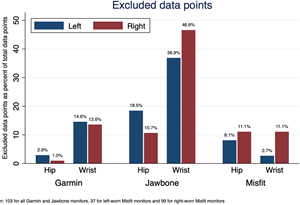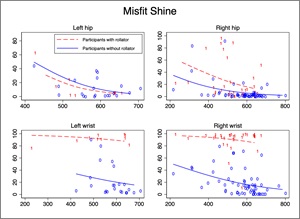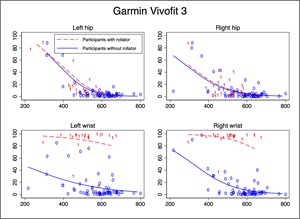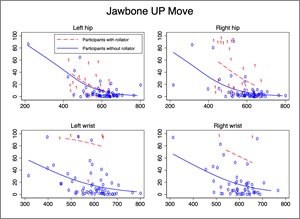Consumer-grade physical activity monitors (PAMs) can potentially replace more expensive research-grade PAMs in situations where the level of physical activity should be measured or enhanced in older adults. PAMs does not need not have excellent validity and reliability to serve as facilitators, but if they are to be used in research settings and serve as outcome measurements, validity and reliability are key to trust the results. Clinical studies that use consumer-grade PAMs as outcome measures should use hip-worn devices, especially if the target group include older adults with and without rollators.
To use goal-setting in the individualisation of walking programs, individual feedback on physical activity is crucial. The consumer-grade physical activity monitors (PAMs) hold the potential of being facilitators for increased physical activity as they provide timed feedback, notifications and can be adjusted with individual goals. For these reasons, PAMs are now frequently used with good effect to increase physical activity in older adults. However, before using consumer-grade PAMs in clinical research, the measurement properties, including criterion validity (the ability to measure the construct of interest) in particular, of specific PAMs should be evaluated. Within the population of older adults, a large heterogeneity exists in walking speed, stride length, joint movement, and use of assistive devices, all of which have been found to affect the validity and thus the usability of PAMs. Furthermore, consumer-grade PAMs differ from research-grade PAMs because the algorithms for step detection cannot be modified and thus the definition of a step might differ between PAMs. Hence, there is no transparency in the use of algorithms and most modern consumer-grade PAMs are designed to be worn on the wrist as watches, which might lead to inaccurate measurement as hip-worn PAMs have been reported to outperform wrist-worn PAMs for step accuracy.
The aim of this study was to investigate the criterion validity of four types of consumer-grade PAMs in older adults. We included the Nokia GO, Jawbone UP Move, Misfit Shine and Garmin Vivofit 3. Loss of data due to technical issues was more likely to happen with wrist-worn monitors. The Garmin Vivofit 3 showed the lowest frequency of lost data-points and the Nokia GO was excluded from the study being incapable of synchronizing data. Hip-worn PAMs were superior to wrist-worn PAMs across all participants, participants without and with rollators in terms of criterion validity, absolute difference in steps, absolute measurement error in percentage and difference in steps.




Three of the four included consumer-grade PAMs were analysed and they showed varying measurement properties related to criterion validity among older adults performing a self-paced walking task. Our results show that wrist-worn PAMs cannot measure the number of steps in a population of older adults using rollators. The hip-worn PAMs were not significantly different in terms of measurement error or criterion validity, but when selecting a PAM for a clinical study, investigators should consider both the criterion validity and the rate of data loss as this also varied between monitors.
You can view the full article here